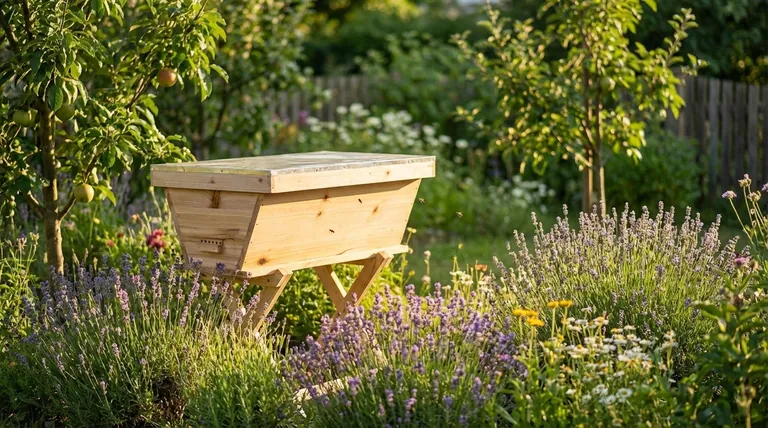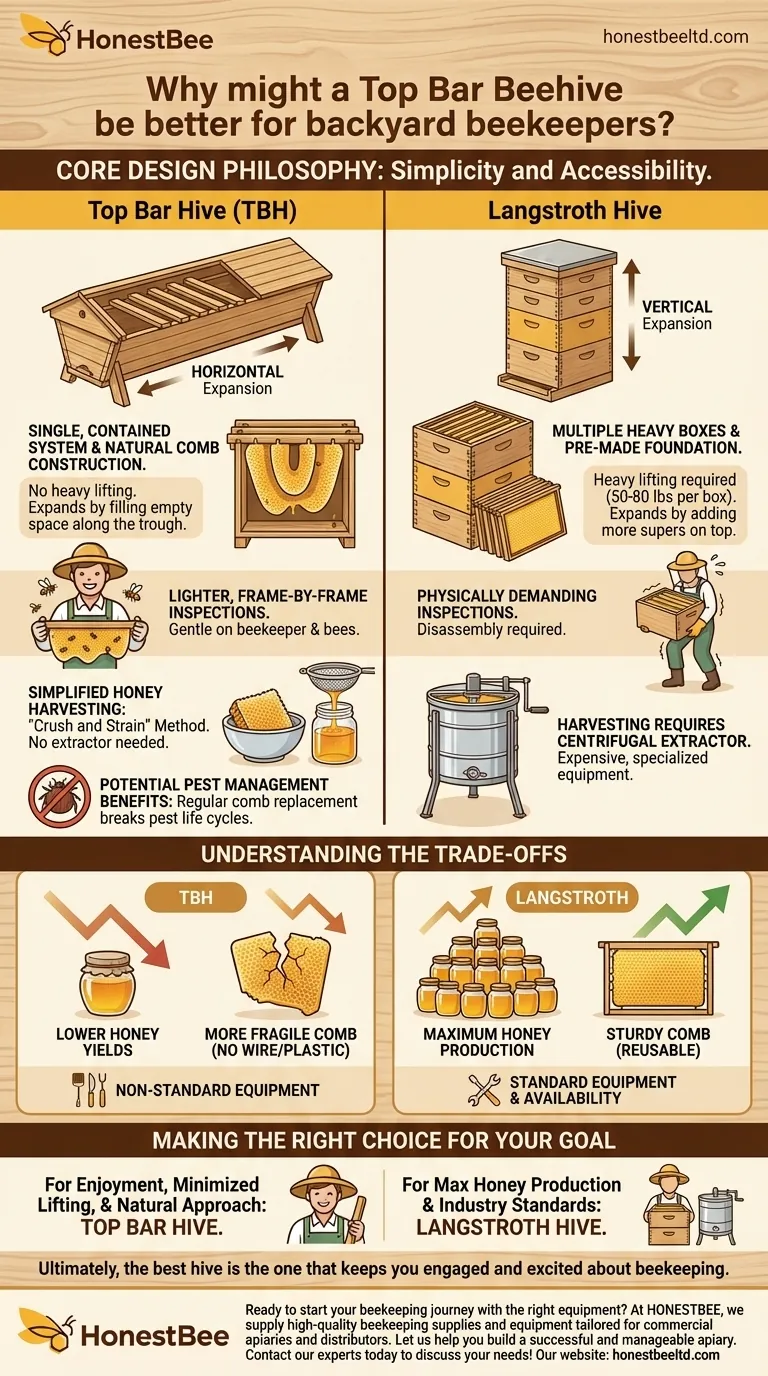In short, a Top Bar Beehive is often better for backyard beekeepers because it is specifically designed for ease of management rather than for industrial-scale honey production. Its single, horizontal box eliminates the need for heavy lifting, and inspections involve handling one light bar at a time, making it far more physically accessible for the hobbyist.
The core appeal of the Top Bar Hive lies in its philosophy: it prioritizes the beekeeper's experience and a less intrusive approach. This makes it an excellent choice for those who value simplicity and physical comfort over maximizing honey yield.

The Core Design Philosophy: Simplicity and Accessibility
The fundamental difference between a Top Bar Hive (TBH) and other common hives, like the Langstroth, is its horizontal structure. This single design choice has significant implications for how you manage your bees.
Horizontal vs. Vertical Expansion
A TBH is a single long trough. As the colony grows, it expands horizontally along the series of bars, filling the empty space inside the box.
This is a stark contrast to Langstroth hives, which expand vertically. Growth requires adding heavy boxes (called "supers"), which can weigh 50-80 pounds when full of honey, on top of the existing stack. For many, lifting these boxes is the most physically demanding part of beekeeping.
A Single, Contained System
In a TBH, the brood nest, pollen stores, and honey are all located in one continuous cavity. This simplifies inspections because you don't have to disassemble and reassemble multiple heavy boxes to see the colony's health.
Natural Comb Construction
TBHs use simple wooden bars across the top of the hive. Bees build their comb naturally, drawing it down from the center guide on each bar without the need for pre-made foundation sheets. Many beekeepers feel this is a more natural and bee-centric approach.
Practical Advantages in Management and Harvest
The design of a TBH directly translates into a more straightforward and less physically strenuous beekeeping experience, especially for hobbyists.
Lighter, Frame-by-Frame Inspections
To inspect a TBH, you gently smoke the bees and lift one bar at a time. Each bar, even when full of comb and honey, is relatively lightweight and easy to handle.
This process is less disruptive to the colony than removing an entire box and is significantly easier on the beekeeper's back.
Simplified Honey Harvesting
Harvesting honey from a TBH does not require an expensive centrifugal extractor. The most common method is "crush and strain."
You simply cut the honeycomb from the bar, crush it to break open the cells, and let the honey drain through a sieve or filter. A simple honey press can make this process even more efficient, separating the honey from the valuable beeswax.
Potential Pest Management Benefits
Because you harvest the entire comb, the bees are constantly building new, clean wax. This regular comb replacement can help break the life cycle of pests and pathogens, such as the Varroa mite, that can accumulate in old brood comb.
Understanding the Trade-offs
The simplicity of the Top Bar Hive comes with important considerations. It is not the ideal hive for every goal.
Lower Honey Yields
A TBH is not designed for maximum honey production. The crush and strain method destroys the comb, forcing the bees to expend significant energy rebuilding it. This, combined with a smaller overall colony size, generally results in less surplus honey compared to a Langstroth hive.
More Fragile Comb
The naturally drawn comb has no internal wire or plastic support. It is attached only to the top bar and can be very fragile, especially when new or in hot weather. It requires slow, careful handling to prevent it from breaking off the bar.
Non-Standard Equipment
The Langstroth hive is the dominant standard in many parts of the world. This means parts, tools, and accessories are widely available. TBH equipment is less standardized and not interchangeable, which can make sourcing gear slightly more challenging.
Making the Right Choice for Your Goal
Selecting a hive is about aligning the equipment with your personal beekeeping philosophy and physical abilities.
- If your primary focus is enjoying the process, minimizing heavy lifting, and a more "natural" approach: The Top Bar Hive is an outstanding choice that aligns perfectly with these goals.
- If your primary focus is maximizing honey production or using industry-standard equipment: You may be better served by a Langstroth hive, which is designed for efficient expansion and honey harvesting.
Ultimately, the best hive is the one that keeps you engaged and excited about the craft of beekeeping.
Summary Table:
| Feature | Top Bar Hive Advantage |
|---|---|
| Physical Effort | No heavy lifting; single, lightweight bars |
| Inspections | Simple, frame-by-frame process |
| Honey Harvesting | Simple 'crush and strain' method; no extractor needed |
| Design Philosophy | Natural comb building; less intrusive for bees |
Ready to start your beekeeping journey with the right equipment? At HONESTBEE, we supply high-quality beekeeping supplies and equipment tailored for commercial apiaries and distributors. Let us help you build a successful and manageable apiary. Contact our experts today to discuss your needs!
Visual Guide

Related Products
- Top Bar Beehive for Beekeeping Wholesales Kenya Top Bar Hive
- Long Langstroth Style Horizontal Top Bar Hive for Wholesale
- HONESTBEE Professional Long Handled Hive Tool with Precision Cutting Blade
- HONESTBEE Professional Multi-Functional Hive Tool with Ergonomic Wood Handle
- HONESTBEE Advanced Ergonomic Stainless Steel Hive Tool for Beekeeping
People Also Ask
- What are the benefits of extra wax production in top bar hives? A Natural Byproduct for Craft & Efficiency
- Why are hive inspections easier with Top Bar Hives? Achieve a Calmer, Safer Approach to Beekeeping
- What is the quickest method to harvest honey from a top bar hive? A Guide to the Simple 'Cut and Crush' Method
- What are the benefits of a top bar hive? A Natural, Low-Impact Approach to Beekeeping
- How is honey harvested from a top-bar hive? A Guide to Simple, Low-Equipment Processing



















